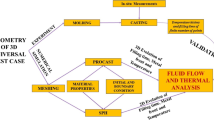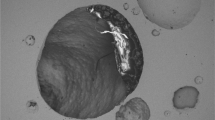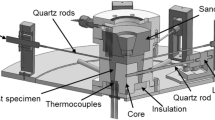Abstract
Gravity casting has been applied extensively. Cavity will occur in the casting and form shrinkage cavity in solidification due to volume reduction and lowering of liquid metal level, which will affect casting quality. The formation process of shrinkage cavity cannot be directly observed and needs to be displayed by using the numerical simulation method. The smoothed particle hydrodynamics (SPH) method is a pure Lagrange method with no grids and has now been applied in casting numerical simulation, but the prediction model of the shrinkage cavity in gravity casting solidification based on the SPH method has not been reported. In this paper, the mathematical model for temperature field (including latent heat treatment) and shrinkage cavity prediction in solidification is established based on the SPH method. The correctness for the temperature field (including latent heat treatment) is validated by computing temperature field in the solidification of an L-shaped aluminum alloy casting, and correctness for the prediction of shrinkage cavity is validated by computing the shrinkage cavity in the solidification of a cylindrical steel casting.





Similar content being viewed by others
Data Availability
The data used to support the findings of this study are available from the corresponding author upon request.
References
He Y, Zhou Z, Cao W, Chen W (2011) Simulation of mould filling process using smoothed particle hydrodynamics. Trans Nonferrous Metals Soc China 21(12):2684–2692
Colagrossi A, Landrini M (2003) Numerical simulation of interfacial flows by smoothed particle hydrodanamics. J Comput Phys 191(2):448–475
Hu XY, Adams NA (2007) An incompressible multi-phase SPH method. J Comput Phys 227(1):264–278
Chen FZ, Qiang HF, Gao WR (2017) A coupled SDPH–FVM method for gas-particle multi-phase flows: methodology. Int J Numer Meth Eng 109(1):73–101
Han YW, Qiang HF, Huang QZ et al (2013) Improved Implicit SPH Method for simulating free surface flows of power law fluids. Sci China Technol Sci 56(10):2480–2490
Hongfu Q, Chao S, Fuzhen C, Yawei H (2013) Simulation of two-dimensional droplet collisions based on SPH method of multi-phase flows with large density difference. Acta Phys Sin 62(21):214701
Yawei H, Hongfu Q (2012) An improved SPH method with physical viscosity and application in dam-break problem. Chin J Comput Phys 61(5):693–699
Niu XF, Song ZL, Fang Z, Hu L, Wang HX, Zhao JY (2018) Numerical simulation of casting filling process of composites reinforced with nano SiC based on smoothed particle hydrodynamics. J Nanosci Nanotechnol 18(12):8169–8177
Hu MY, Cai JJ, Li N, Yu HL, Zhang Y, Sun B, Sun WL (2018) Flow modeling in high-pressure die-casting processes using SPH model. Int J Metalcast 12(1):97–105
Cleary PW, Ha J, Prakash M, Nguyen T (2010) Short shots and industrial case studies: understanding fluid flow and solidification in high pressure die casting. Appl Math Model 34(8):2018–2033
Cleary PW (2010) Extension of SPH to predict feeding, freezing and defect creation in low pressure die casting. Appl Math Model 34(11):3189–3201
Shoumei X, Qingyan X (2001) Simulation technology in casting. China Machine Press, Beijing
Qiang H (2017) New method and application of smooth particle hydrodynamics. China Science Publishing & Media Ltd., Beijing
Liu GR, Liu MB (2003) Smoothed particle hydrodynamics: a meshfree particle method. World Scientific Publishing Co Pte Ltd., Singapore
Antuono M, Colagrossi A, Marrone S, Molteni D (2010) Free-surface flows solved by means of SPH schemes with numerical diffusive terms. Comput Phys Commun 181:532–549
Tiexiong S, Liqian Ma, Moubin L, Jianzhong C (2013) A numerical analysis of drop impact on solid surfaces by using smoothed particle hydrodynamics method. Acta Phys Sin 62(6):064702
Rook R, Yildiz M, Dost S (2007) Modeling transient heat transfer using SPH and implicit time integration. Numer Heat Transf 51:1–23
Cleary PW, Monaghan JJ (1999) Conduction modeling using smoothed particle hydrodynamics. J Comput Phys 148:227–264
Hu MY, Cai JJ, Li N, Yu HL et al (2018) Flow modeling in high-pressure die-casting processes using SPH model international. Int J Metalcast 12(1):97–105
Sui D, Cui Z (2008) Numerical simulation of 3D transient temperature field in aluminum alloy solidification process. Chin J Nonferrous Metals 18(7):1311–1316
Hua H, Hongkui M, Guowei Z (2008) Computer simulation in casting. National Defense Industry Press, Beijing
Acknowledgements
This research has been financially supported by the National Natural Science Foundation of China (Nos. 51874209, 51574176); Major Research and Development Plan of Shanxi Province (International Cooperation Project) (201603D421028).
Author information
Authors and Affiliations
Corresponding author
Ethics declarations
Conflict of interest
The authors declare that they have no conflict of interest.
Additional information
Publisher's Note
Springer Nature remains neutral with regard to jurisdictional claims in published maps and institutional affiliations.
Rights and permissions
About this article
Cite this article
Niu, X., Zhao, J. & Wang, B. Application of smooth particle hydrodynamics (SPH) method in gravity casting shrinkage cavity prediction. Comp. Part. Mech. 6, 803–810 (2019). https://doi.org/10.1007/s40571-019-00263-y
Received:
Revised:
Accepted:
Published:
Issue Date:
DOI: https://doi.org/10.1007/s40571-019-00263-y




